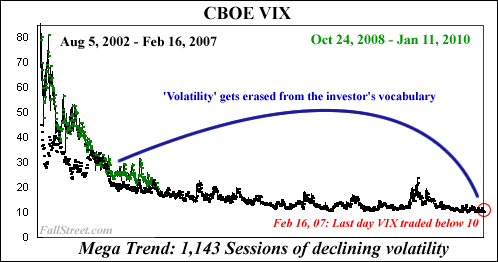
January 13, 2010
The Death of Volatility, Part II?
In a recent article the Wall Street Journal noted that the ‘VIX Is No Crystal Ball’, adding that ‘it [the VIX] almost never leads the market in either direction.’ Given that the VIX itself is simply a computation of [options] market activity, this information borders on the pointless. Nevertheless, with many analysts focused on the sharp decline in volatility to begin 2010 this topic is not going away.
The latest slump in volatility has caught the attention of many analysts because the VIX has held below 20 (historically a sign of investor complacency), and because stock prices are long overdue for a correction. While it is difficult to offer an opinion on this development, it is safe to say that should the VIX keep falling and/or stock prices keep rising contrarian spirits will become more aroused.
Longer-term VIX Movements
On January 11, 2010 the VIX traded below 17 for the first time since May 2008.
The recent slump in the VIX has mirrored the previous downturn in the index: 305-trading sessions after peaking at 89.53 on October 24, 2008 the VIX is at the exact same level it was 305-trading session after its August 5, 2002 peak of 45.03 (17.55 on January 11, 2010 versus 17.62 on October 16, 2003).
 |
The data missing from the above charts is displayed below. Note how once volatility moved above its freakishly low sub-10 reading it never returned.
 |
What marked the beginning of this major trend change in the VIX? Consider Goldman, Merrill Almost `Junk,' Their Own Traders Say, dated March 2, 2007:
“Lehman and Bear Stearns credit swaps traded as if their debt were rated four levels lower than their A1 rankings…”
In other words, hindsight tells us that VIX spike in early 2007 (and the events surrounding/prompting it) signaled a coming tsunami of problems for the U.S. economy and financial markets.
With this in mind, one suggestion may be the next time the VIX spikes sharply higher read the headlines closely and try to determine whether the issues influencing the spike are burgeoning or transient. In the case of yesterday’s tiny move higher in the VIX, a predetermined pessimist expecting say Japan to soon default could relate it with the following:
“The cost of protecting Asia-Pacific corporate and sovereign bonds from default rose on U.S. earnings concerns and after China’s central bank unexpectedly moved to restrain lending…”
Given that it may be foolish to carry this potentially specious reasoning much further, let me close by saying that in the absence of a major world event a sustained move higher in the VIX is unlikely to occur until either the secular bear market returns and/or the U.S. nears another recession. That neither of these events is on the radar screen today largely explains why the VIX is trending lower…